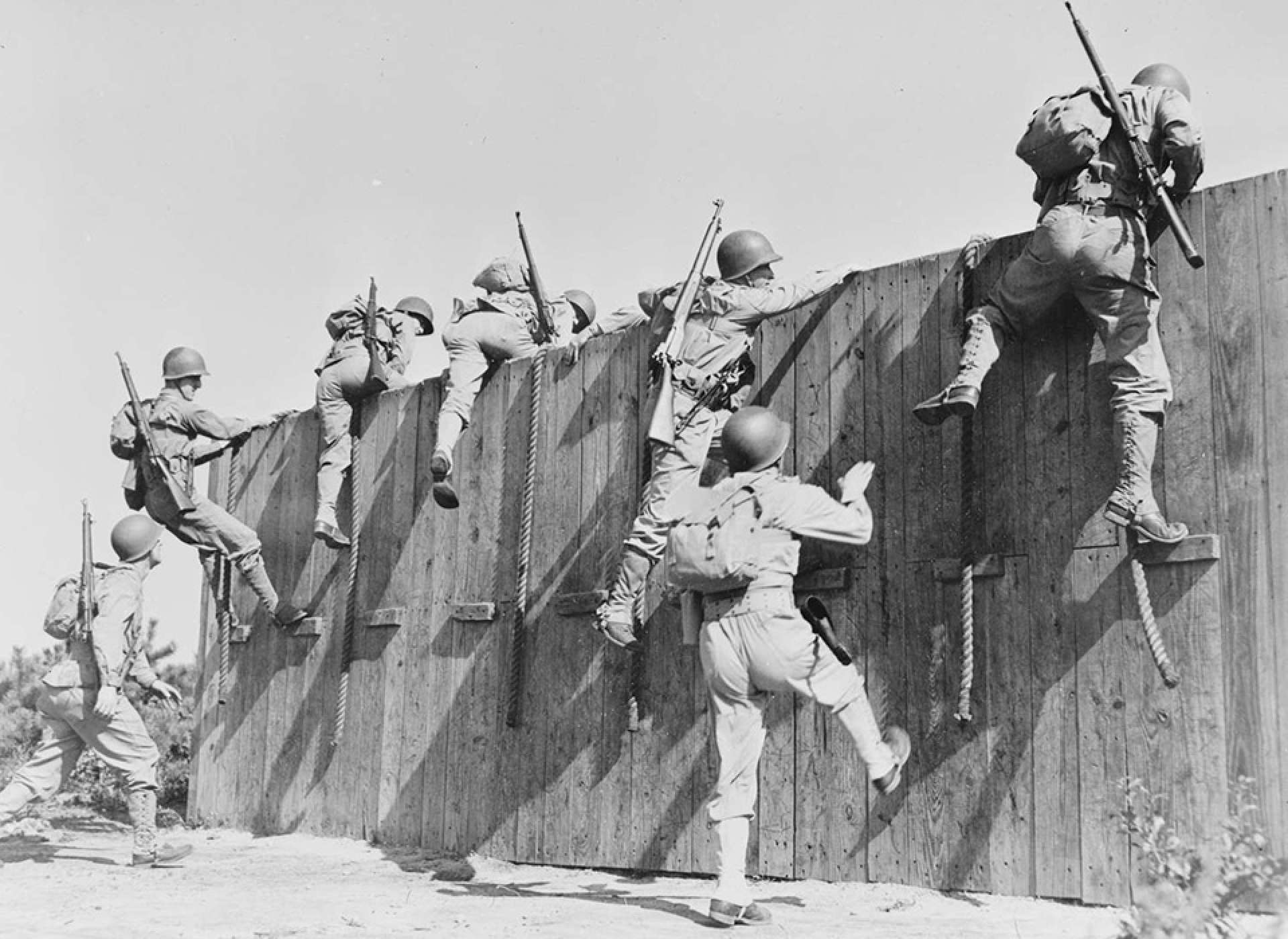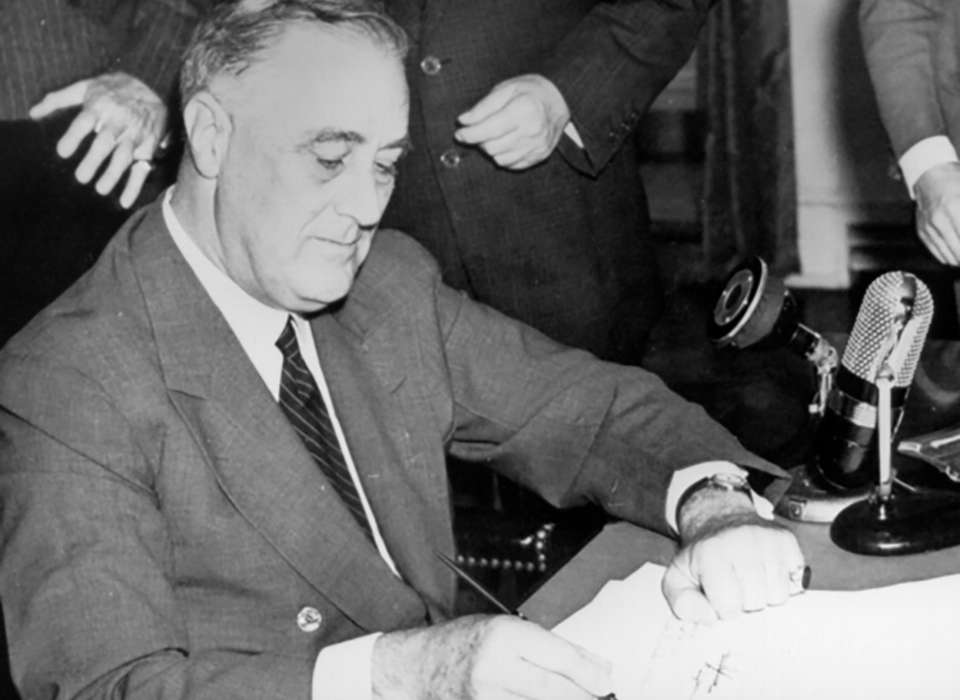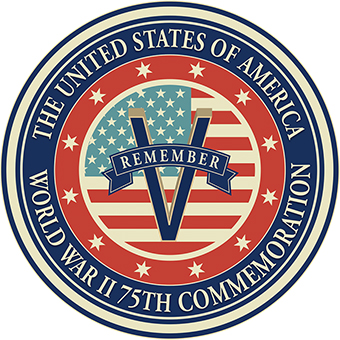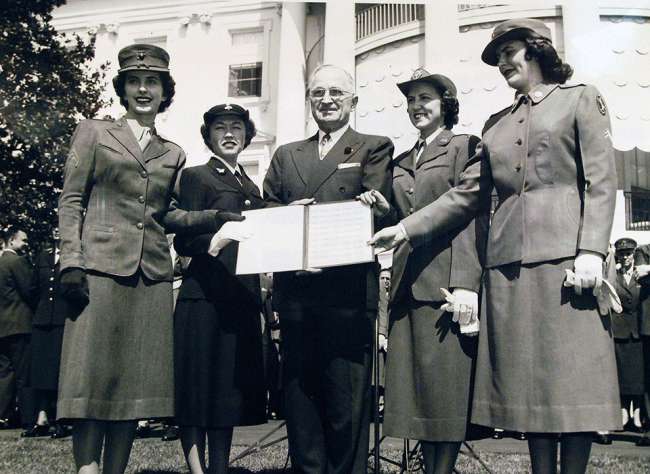Top Image: President Franklin D. Roosevelt signs the Selective Training and Service Acto of 1940, creating the first peacetime draft. Image courtesy of the Selective Service System.
As World War II wound down, Americans living all over the world took to their typewriters and sharpened their pencils. From servicemembers stationed overseas to mothers in their midwestern living rooms, these citizens wrote tens of thousands of letters. They wanted their local communities, their congressmembers, and President Harry Truman to know what they thought about the future of military service in the United States.
Competing visions for the future of American foreign policy, the realities of administering occupations on two continents, and different understandings of military service created a complicated—and highly political—situation. Soldiers abroad and their families complained about the Army’s point system, which was used to prioritize men for rotation home. Parents of teenagers argued that their 18-year-old sons were too young to be drafted now that the war emergency was over. Boosters claimed compulsory military service would turn America’s youth into men and benefit the nation as a whole. Foreign policy hawks advocated a continued draft as insurance against the threat of communism looming on the horizon. The War Department just wanted enough men to maintain occupation forces in Japan and Germany.
Military manpower, like so much else, was at a crossroads.
When Congress passed the Selective Training and Service Act of 1940 to establish conscription, it was a significant break from the past. Going all the way back to colonists’ pre-Revolutionary War experience with British soldiers quartered in their homes, Americans have associated a large standing army with the potential for tyranny. As a result, US forces have traditionally been kept small, expanding—often through a draft—only during wartime and then contracting again after fighting stopped. A draft without a declaration of war was new—and potentially worrisome to many.
On the other hand, by 1940, it was clear that the United States was likely to enter the fray, Although this draft was officially America’s first peace-time draft, almost everyone knew peace wouldn’t last for long. And in the meantime, Congress limited the Selective Service’s reach considerably. Draft calls were kept low, draftees were forbidden from serving outside of US territorial possessions, and deferments from conscription were easy to come by. Most Americans just accepted it and moved on.
But the climate after World War II was different. Policy makers agreed that the world was changing, but they didn’t agree how. And they, just like the public, developed different visions for manning the military. Three main positions emerged: returning to the pre-war status quo of a small all-volunteer force, maintenance of a larger military populated by conscription, and universal military training (UMT).
By 1945, UMT had surged to the forefront of available options. Specific plans varied, but all of UMT’s advocates agreed that exposing all able-bodied American men to some amount of compulsory military training had tremendous benefits. Six months to one year of training would expose men to military organization, familiarize them with weaponry and tactical basics, and increase physical fitness, all with the purpose of creating a general reserve that could be mobilized quickly in the event of another war. UMT, supporters hoped, would allow the standing force to shrink to pre-war levels once again and make a draft obsolete. If war came, the trained general reserve would be available faster than the Selective Service could crank into gear.
Such leading lights as Army Chief of Staff George Marshall, Secretary of War Henry Stimson, and Brigadier General John McAuley Palmer went even further. They argued that UMT would act as a deterrent to war itself. Marshall even claimed that “Germany would not have dared to involve herself in a war that would draw the United States into the conflict” if only the United States had “followed through” in creating a program of UMT when it was first proposed three decades earlier. By the end of 1945, Secretary of the Navy James Forrestal, Admiral Chester Nimitz, and General Dwight Eisenhower had all come out in favor of UMT as a vital national security measure.
Other proponents of UMT, both within and outside of the military planning community, attributed an entirely different value to compulsory training. The beauty of UMT, they argued, was that even though men would train at military camps under military discipline, they would remain civilians. The military would not induct the trainees. Training, therefore, would bring together the best of military and civilian worlds. Trainees would learn discipline and common standards of cleanliness. They could develop job skills and receive literacy training. They would receive basic health care. And training would bring men from all over the country, from all different religious, ethnic, and socio-economic backgrounds, together under a single roof. UMT, claimed Stimson, would “rub smooth the sharp edges of prejudice, sectionalism, and lack of understanding between groups.”

Soldiers tackle part of an obstacle course at Camp Edwards, Massachusetts, 1942. Image courtesy of the Library Of Congress, LC-USW33-000257-ZC.
None of these UMT supporters seemed to care that only able-bodied men would be able to access the training and its intended benefits. Nor did it bother them that training would take place within a racially segregated institution. The divisions of gender, physical ability, and race were too large, too accepted, and too hard to “rub smooth,” it seemed.
The general public liked the idea of UMT. Some opinion polls ranged as high as 83 percent approval. Gallup polls between 1945 and 1956 showed public favor consistently above 65 percent. In a post-atomic age, measures promoting safety, military readiness, and unity were high on Americans’ priority list. Yet poll after poll also showed that UMT was not most people’s priority. On balance, Americans like the idea in theory, but most weren’t prepared to fight for it. As with any proposed policy, however, UMT did not appeal to everyone. A cadre of committed opponents from a variety of backgrounds emerged. They did not agree on very much beyond their disapproval of universal training, but their combined voice, paired with the beginnings of the Cold War and growing fear of nuclear warfare, pushed the national manpower conversation toward other options.
Pacifist, anti-militarist, and internationalist activists all begged Congress to end conscription, shelf UMT, and give the new United Nations time to establish its global authority. Peace, they argued, could not flourish with the United States waiting in the wings with a massive military or an even larger militarily trained populace. In an “international jungle,” warned federal judge William Hastie,
“there is no tolerable future … in which each lion calls himself the king of the beasts and keeps sharpening his claws to prove it.”
William Hastie
Too much preparedness did not guarantee peace; it bred war.
Educational, medical, and religious activists warned of the dangers inherent in military training. Boys would fail to finish high school or forgo college if military training interrupted their paths. The moral cesspits of military camps, which operated well away from the steadying hands of parents, church, and community, would introduce America’s youth to the temptations of alcohol, gambling, and sex. Boys’ emotional growth would stunt, making them less independent and more susceptible to regimentation, militarism, and eventually the thrall of fascism or totalitarianism. UMT, to these protestors, was a slippery slope.
Activists on both sides of the racial divide also attacked plans for UMT. Civil rights advocates could not support any program that deepened segregation, which was guaranteed to happen so long as the military remained racially segregated. Segregationists vowed to stymie any program that allowed for racially integrated units.
Finally, some conservatives, led by Senator Robert Taft of Ohio, argued that UMT was a vast government overreach. In the wake of World War II, when approximately 10 million of the 16 million men who served in uniform had been drafted, few politicians argued against the constitutionality of conscription (although Taft had fought against the draft in 1940, before the United States declared war). But universal peacetime training was a bridge too far.
By the winter of 1946-47, the Truman administration tried to move ahead with UMT. Truman convened a presidential commission to examine the feasibility. The commission’s report, released in the spring, enthusiastically endorsed the measure. Meanwhile, the Department of the Army initiated an “experimental unit” at Fort Knox to test new policies and training methods for UMT platoons. Army leadership brought hundreds of reporters, civic leaders, and other interested individuals to Kentucky to observe the unit in action. And, most importantly, Congress, with the backing of the War Department, finally let the Selective Training and Service Act expire. Conscription stopped, theoretically to pave the way for UMT to pass Congress.
But political wrangling bogged down bill after bill. Three years after those first letter writers had begun to fill Truman’s mailbox, the three positions on the future of military manpower had barely budged. Very few of those involved in the debate changed their opinion over time. One group vehemently opposed a large military under any guise. One group argued that UMT would provide national security against external enemies and strengthen the nation from within. And the third continued to advocate for a renewed draft as the only way to keep the military large enough to face global threats. But the majority of Americans—those who didn’t bother writing to the president or their congressmembers—regardless of their private leanings, weren’t willing to lobby in any particular direction.
Ultimately, it was the growing Cold War that settled the issue.
Without the threat of the draft breathing down their necks, young men stopped enlisting. When Czechoslovakia “fell” to communism in early 1948, US combined forces were understrength by almost 150,000 men, prompting Truman to ask for a reinstatement of the draft. When the Soviet Union cut off access to West Berlin a few months later, Congress obliged. The peace-time draft was back.
This time, however, it was clear that conscription was not meant as an emergency measure, even as it had been in 1940. It was to become the new normal, through both peace and war, at least through the immediate future.
Meet the Author
Amy J. Rutenberg is an Associate Professor of History at Iowa State University and the author of Rough Draft: Cold War Military Manpower Policy and the Origins of Vietnam-Era Draft Resistance (Cornell University Press, 2019). Headshot courtesy of Iowa State University, Department of History.
This article is part of a series commemorating the 75th anniversary of the end of World War II made possible by the Department of Defense.
Cite this article:
MLA Citation:
APA Citation:
Chicago Style Citation:










